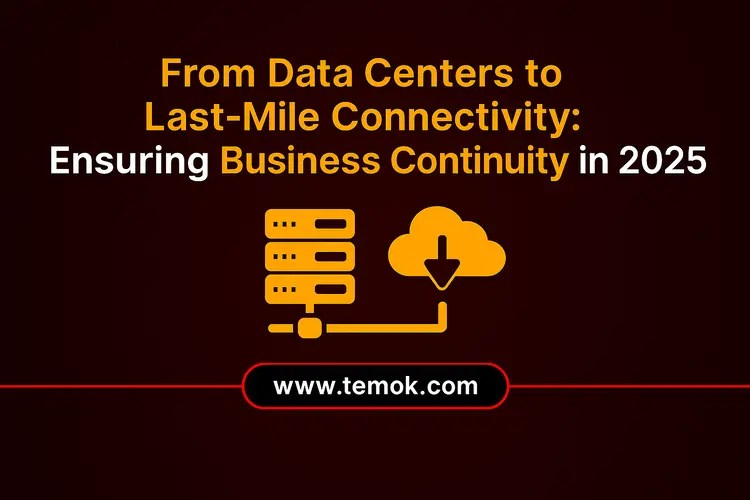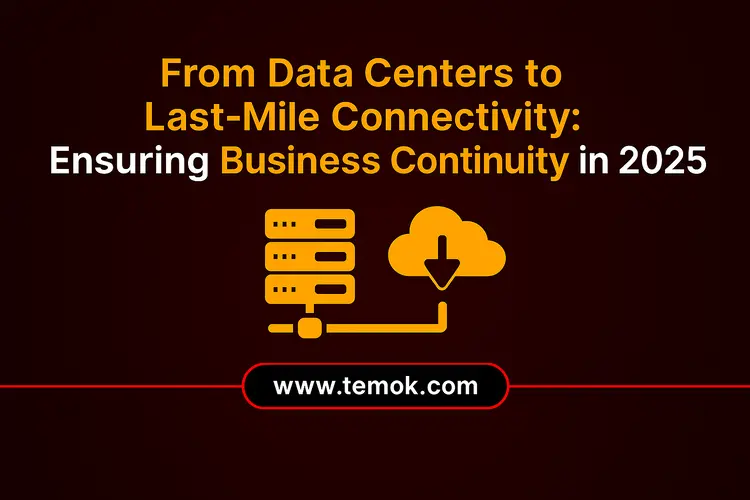A single broken cable can stop an app used by millions. For end users, it’s often a brief interruption; for businesses, it can mean lost revenue and damaged trust, plus a flood of support tickets.
In 2025, dependable business continuity rests on a deceptively simple idea: the network must perform from major hubs down to the street corner. Achieving that requires hardened data center connectivity, resilient last-mile links, and crews who execute reliably.

Table of Contents
Why Connectivity Matters For Business Continuity
Every company now depends on uninterrupted digital service. Retailers must accept payments, healthcare providers need access to patient records, logistics platforms coordinate deliveries, and SaaS companies run mission-critical apps.
The stakes are high. An hour of downtime can cost large enterprises millions, while a few minutes can disrupt supply chains, force manual workarounds, or prevent a small business from processing transactions.
When people discuss business continuity in 2025, the focus often centers on cloud platforms and disaster recovery plans. Those matters, but broader continuity depends on both the strength of core infrastructure in high availability networks and the quality of the connections that deliver services into homes, offices, and stores. Without attention to both, gaps appear.
Data Centers: The Digital Backbone
Data centers host applications, store backups, and exchange traffic between clouds. Engineers build redundancy through cross-connects, peering, and diverse equipment to ensure a failed switch or cabinet does not bring a facility down.
Good data center connectivity encompasses two key aspects. First, internal paths must not fail. Second, the exits from that facility need diverse routes. That means multiple fiber paths to different providers. It means planning for power changes and for equipment failures. These steps keep high availability networks healthy.
A simple example helps here. If a SaaS company’s primary fiber provider has an issue, their network should instantly reroute traffic through a secondary carrier. Customers never notice. That seamless experience is the result of careful design and routine testing, not luck.
Also Read: Datacenter or Data Center: Why Both Terms Mean The Same
The Connectivity Gap: From Core Networks To The Last Mile
Now let’s move from those big facilities to the edges of the network. This is where cracks often show. Last-mile connectivity refers to the final stretch that links a network to the end user. It could be a fiber line running down a suburban street, a cable into an urban high-rise, or a long rural run across farmland.
Why does this matter so much? Because the last mile is where the physical world collides with digital promises. That leg runs through city ducts, across neighborhoods, or down to a rural main street.
Here’s why this link is weak:
- Permits and rights: Local rules slow fiber builds in cities. Work windows are limited.
- Physical obstacles: Multi dwelling units and older buildings complicate cabling.
- Distance and economics: Rural routes require long runs and higher cost per user.
The result is that many businesses treat the last mile as a given, until it fails. A retail chain may invest heavily in cloud redundancy, only to discover that a single fiber cut in a strip mall can shut down checkout systems across several stores. The backbone stays up, but customers still walk out.
This gap between core reliability and last-mile fragility is why continuity planning needs to extend all the way to the ground level.
Planning The Infrastructure Right
Good outcomes start on paper. Network planning maps routes, checks permits, and calls out risks. It sets capacity goals and maintenance windows. It defines diversity so a single cut will not stop service.
Practical steps in planning
- Route survey: Walk the route. Note poles, ducts, and obstacles.
- Permitting map: List local authority needs and timelines.
- Capacity forecast: Size fibers and ports for three to five years.
- Compliance checks: Confirm local codes and building rules.
If you want help to remove friction, consider a specialized network-planning firm that handles surveys and permits. They keep work moving and reduce surprises. Solid network planning lowers cost and improves uptime and reliability. It also makes field work safer and faster.
Executing On The Ground
Plans stay mere words if crews do not execute. Field service deployment brings fiber, cables, and gear into reality. Technicians splice fibers. They run risers. They terminate connectors and validate performance. They respond to outages and fix faults.
Core field tasks
- Fiber install and splice: Create new routes and repair breaks.
- Structured cabling: Serve buildings and closets.
- Turn up and test: Verify signal levels and latency.
- Break fix: Respond to faults under SLA.
A national field team helps when you need consistent installs across regions. A national field services provider can dispatch crews, track tasks, and maintain standards. Without skilled field support, even the best-designed data center connectivity can fall apart when it meets real-world conditions.
The Future Outlook For Business Continuity in 2025 And Beyond

Edge computing and IoT push computing closer to users. That trend changes the balance between core and edge. You will see more micro data sites near population centers. You will rely on local routers and caches to keep latency low.
What stays true is this. Reliable services need strong core links and robust last-mile links. You need high availability networks across both domains. You need a plan for growth and crews who can carry that plan into the field.
Think about hybrid models. An enterprise may keep critical systems in a regional data center and use the cloud for peak loads. That setup works only if the routes between points are tested and diverse. Use simple tests. Route failovers matter. Service level targets matter. Ask your team to run failover drills.
Plan And Execute For Reliable Operations
You do not need to overhaul everything at once. Start small and measurable.
A short checklist
- Map critical routes and mark the last-mile handoffs.
- Confirm a secondary path for each important site.
- Run a test call from a random site to the data center.
- Ensure permits are tracked with dates and contacts.
- Standardize acceptance tests for field crews.
- Reserve spare fibers or ports where possible.
- Monitor both core and last-mile links with the same tooling.
- Document an incident playbook and update it after each event.
- Set repair targets and verify SLAs with your provider.
- Run a full failover drill twice a year.
Fixing one item on this list can reduce downtime dramatically. Small moves teach teams how systems behave. Those lessons make future choices clearer.
Closing Thought: Practical Steps, Real Results
Reliable business continuity in 2025 comes from two things: strong network planning builds a path that can survive trouble, and consistent field service deployment makes that path real. When planning and field work align, you get measurable uptime and reliability.
You can do this without a huge budget. Start with a map of your routes. Run a test on one customer site. Fix the first problem you find. Small steps add up. The outcome is steady service for your users and less stress for your team.
Which step will you take this week to protect your users?
